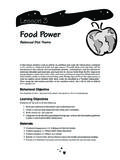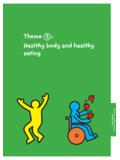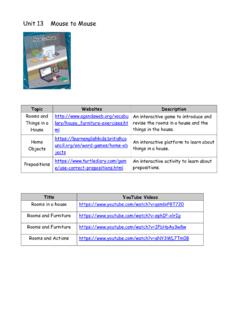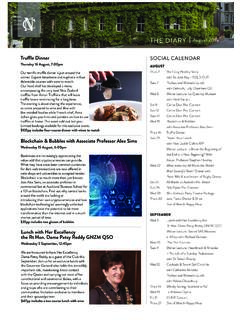Transcription of Passing the Sugar - Planet Health
1 Lesson 19. Passing the Sugar Balanced Diet Theme This lesson integrates chemistry, physiology, math, and Health concepts. Students estimate the number of sodas and sport drinks they drink in a week and calculate and measure out the grams and teaspoons of Sugar contained in these drinks. Through a reading, they learn that drinking Sugar -sweetened beverages provide empty calories and that excessive intake has been linked to an increased risk for developing Health problems such as type 2. diabetes. Therefore, they need to choose beverages without added sugars. They are also introduced to the chemical structure and function of simple sugars and learn how the diges- tive, cardiorespiratory, and endocrine systems interact to deliver fuel to muscles. Optional role plays and movement activities offer students opportunities to visualize some of the abstract concepts presented. Finally, students investigate the Sugar content of foods found in their homes. This lesson is best suited for eighth-graders and advanced seventh-graders.
2 However, most sixth- and seventh-graders are able to complete activities and See the lesson procedure for ideas on modifying activities for sixth- and seventh-graders. Behavioral Objective For students to choose beverages without added sugars or artificial sweeteners Learning Objectives Students will be able to do the following: 1. Use a triple beam balance to accurately weigh material 2. Use formulas to convert between volume and mass measurement units 3. Recognize that the measurement of volume and mass requires an understanding of the sensitivity of measurement tools and knowledge of which sensitivity is necessary for a particular task 4. Describe the chemical structure and function of simple sugars and give examples of sugars added to foods 243. Lesson 19 Passing the Sugar 5. Describe how the digestive, cardiorespiratory, and endocrine systems interact to deliver fuel to working muscles 6. Recognize that the consumption of excessive amounts of Sugar -sweetened beverages can increase a person's risk of developing type 2 diabetes 7.
3 Distinguish between situations in which to drink water and situations in which to drink sport beverages 8. Use food labels to compare and contrast the Sugar content of foods Materials activity activity , Soda and Sport Drinks: How Many Do You Drink? Two 5 lb ( kg) bags of Sugar (can be saved and reused). Each group of four students will need the following: Four empty 20 oz (600 ml) plastic soda bottles Two small beakers Four large beakers Two teaspoons (measuring spoon if possible). Triple beam balance activity activity , Sugary Sport Drinks? Optional activity , Added Sugar Sleuth Student resource , Organ and Cell Name Tags Procedure This lesson is best suited for eighth-graders and advanced seventh-graders. However, most sixth- and seventh-graders are able to complete activities and Teachers working with sixth-graders should do the activity reading as a group, stopping to discuss the words students are not familiar or reviewing them prior to beginning the activity . Before doing activity , sixth-graders may also need a quick review of how to read a nutrition label and a review of the various names for Sugar (see step 6 of the procedure).
4 Engage 1. Ask students to think about and reflect on the following questions: How many sodas and sport drinks did you drink over the past seven days? What's the main ingredient in these drinks? How many teaspoons (ml) of Sugar do you think are in a 12-ounce (375 ml) can of coke? A 20-ounce (600 ml) bottle of Gatorade? What happens to the Sugar from these drinks once it enters your body? Where does it go? What effect does it have on the chemistry of your body? What effect does it have on your performance in school or sports? Listen to their answers, but don't provide them with answers to the questions. Tell that they will explore the answers to these questions during this lesson. Optional: In preparation for activity , Soda and Sport Drinks: How Many Do You Drink?, you may want to have students keep a beverage diary because some stu- dents have difficulty remembering what they drink. 244. Lesson 19 Passing the Sugar Beverage type Serving size Day (milk, soda, juice, sport drink, water, etc.)
5 (6 oz, 8 oz, 12 oz, 20 oz, etc.). 1 Milk 8 oz 1 Juice 6 oz 2. Hand out activity , Soda and Sport Drinks: How Many Do You Drink? Have stu- dents work individually to complete part I. Explain that this activity will give them the opportunity to reflect on how many high- Sugar drinks they consumed last week and calculate how much Sugar they ingested. You may need to review how to read a nutrition label with students. (See lesson 22, Smart Snacks, for instructions and an overhead transparency of a food label.). 3. Review students' responses to questions 1 through 6 to make sure they calculated the answers correctly. Discuss question 6, highlighting the fact that 20-ounce (600-mil- liliter) bottles of sport drinks have about the same amount of Sugar as most 12-ounce (375-milliliter) sodas. 4. Assign activity for homework. This is especially appropriate if you will not be doing activity Explain that you want students to explore their cupboards looking for foods with added sugars.
6 Instruct them to write down the names of foods that have added Sugar as one of the first three ingredients. (Optional: Begin the lesson with this activity . You will need to review how to read a food label [see lesson 22, Smart Snacks] and the names of common sugars [see step 6 of this lesson procedure].). Explore 5. Assign partners or groups of four, depending on equipment availability. Review the instructions for activity , part II. Explain that they will measure out the amount of Sugar in 20-ounce (600-milliliter) sodas and the total amount of Sugar from sodas and sport drinks they consumed last week. They will use two measurement tools . teaspoons and triple beam balances allowing them to compare the accuracy and sensitivity of the two and how each tool is suited for different measurement tasks. (Note: Using balances gives students experience with scientific equipment and a better working understanding of grams. On the other hand, students' practical experience with teaspoons may make it easier for them to understand just how much Sugar they are consuming in these drinks.)
7 Instruct students to collect their materials and complete the investigation. 6. Have students examine a display of the Sugar -filled soda bottles. Invite students to discuss their observations by asking the following: Were you surprised at how much Sugar you're consuming? Why don't we see the Sugar in soda? Is soda a solution, a mixture, or a suspension of Sugar ? What's the difference? Why do you suppose doctors and scientists encourage us to limit our consump- tion of soda and other sugary drinks? 7. Hand out activity , Sugary Sport Drinks? Preview the reading by explaining the following: There are lots of different kinds of sugars. Sucrose is the scientific name for table Sugar . Fructose is found naturally in fruit and is added to sweeten many kinds of manufactured foods. Lactose is found naturally in milk. To identify added sugars in the foods you eat, look for words ending with the suffix ose in the ingredients list found on food labels. List some sugars on the board.
8 245. Lesson 19 Passing the Sugar As you read activity , Sugary Sport Drinks?, you will learn how sugary drinks such as sport drinks, sodas, and fruit punches affect your body chemistry and can increase your risk of developing type 2 diabetes. 8. Direct students to read and complete the questions in activity , Sugary Sport Drinks? This can be finished for homework. To improve comprehension, have students locate the names of the digestive organs mentioned in the reading on a diagram in the classroom or their textbook. Arrange the class in small groups to discuss their answers to the questions in activity Review the main points as a group. Remind the class of the following: Sugar is a carbohydrate, and some Sugar is found naturally in foods. We need to eat carbohydrate because it provides us with energy to move and grow. However, it's important to choose foods such as milk, yogurt, fruits, vegetables, whole grains breads, vitamins, minerals, and other nutrients we need. Sugar -sweetened beverages have only Sugar , and this only adds empty calories.
9 Making healthy choices means choosing drinks and foods without added Sugar . Drinking and eating foods with lots of added Sugar increases your risk for becoming overweight, developing dental cavities, and developing diabetes. (Review healthy drink options discussed in the Teacher Resources under Specific Background Materials.). It's best to avoid diet soft drinks. They contain artificial sweeteners such as Nutra- Sweet, Splenda, and sucralose, that condition you to expect sweetness in drinks and foods. Also, their long-term safety is not fully understood. Expand and Evaluate 9. Allow students to clarify their understanding and show you what they have learned by using one or more of the following activities: Pass the Sugar . Assign students the following roles and distribute student resource , Organ and Cell Name Tags included in the lesson. Instruct students to act out the movement of Sugar from the mouth to various cells in the body. Assign a student director to help them work together to pass Sugar molecules (tennis balls) through the correct sequence of organs and cells.
10 Roles Mouth Esophagus Stomach Small intestine Heart Blood Muscle cell Brain cell Liver cell Director Students need to understand the roles of these organs before they can do the activ- ity. Consider preparing them for the role play by assigning one organ to a group of students (give each group a label), have them look up the functions, and then have groups cooperatively piece together a flow chart on poster board using their labels. This shouldn't take the place of the role play. Some students learn through movement. Do the wave. Divide the class into two groups. Direct them to sit in two parallel lines facing each other. Tell line 1 to do the wave ( , alternate standing up and sitting down). After a very slight delay, instruct line 2 to do the wave. Repeat this several times. Tell students that they just demonstrated what happens to blood glucose and blood insulin after we consume refined starchy food (such as white bread). Ask them if they know which line represents blood glucose?









